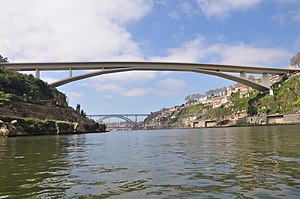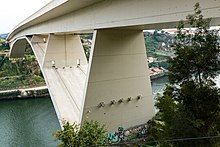Ponte do Infante
Coordinates: 41 ° 8 ′ 28 " N , 8 ° 36 ′ 6" W.
| Ponte do Infante | ||
|---|---|---|
| Ponte do Infante, in the background the Ponte Dom Luís I | ||
| Official name | Ponte Infante Dom Henrique | |
| use | Road bridge | |
| Crossing of | Douro | |
| place | Porto - Vila Nova de Gaia | |
| construction | Concrete arch bridge | |
| overall length | 371 m | |
| width | 20 m | |
| Longest span | 280 m | |
| Arrow height | 25 m | |
| start of building | 1999 | |
| completion | 2002 | |
| opening | 2003 | |
| planner | Adão da Fonseca & Associados | |
| location | ||
|
|
||
The Ponte Infante Dom Henrique , generally only called Ponte do Infante , is a road bridge over the Douro between the old town of Porto and Vila Nova de Gaia .
It is named after Infante Dom Henrique de Avis, better known as Henry the Navigator , who was born in Porto.
It stands in the historic old town around 650 m above the Ponte Dom Luís I , inaugurated in 1886 , the upper level of which has been reserved for the metro do Porto light rail trains since 2004 . About 400 m further upriver is the Ponte Maria Pia , the wrought-iron arch bridge built by Gustave Eiffel and opened in 1877 .
It was inaugurated in 2003, making it the youngest of the bridges over the Douro in Porto.
description
The Ponte do Infante is the main road bridge in the center of Porto. It is 371 long and 20 m wide. With a span of 280 m, it is the widest- spanned bridge in Porto, which is due to the fact that the abutments of its very flat arch are high up on the steep bank and the arch spans the Douro without piers . It has an arrow height of 25 m and thus an arrow ratio of 1: 11.2.
Its elevated, longitudinally curved roadway girder has four lanes and a sidewalk on both sides. The roadway is bordered in the middle and on both sides by low concrete barriers. The actual bridge is followed by the 31.5 m long overpass of a path along the high bank on the northern side.
Your track support consists of a rectangular, single-celled prestressed concrete - concrete box with a seemingly constant height of 4.50 m and a cantilevered deck slab. The reinforced concrete arch is consistently 1.50 m thick and at the top just as wide as the box girder. Its width increases linearly up to 20 m on the transom , which is clearly visible on the trapezoidal panes with which the box girder is elevated. In the central 70 m, the arch unites with the box girder to form a uniform 6 m high box girder. A notch on the sides gives the impression that both the deck girder and the arch are independently continuous construction elements.
The bridge was in cantilever built from both sides of the river here. After the first 35 m, a temporary pillar was erected on each side to support the arch. The bracing was not carried out via temporary towers, but rather diagonal tensioning wires between the box girder, arch and abutments. The box girder had a lead in relation to the "attached" arch, a procedure that was previously only used once. The millimeter-precise adjustment of the height of the provisional towers and of the guy lines in accordance with the loads that change with the progress of construction were regulated with various computer programs and a large number of sensors.
The construction work was carried out between 1999 and October 2002. The bridge was inaugurated in March 2003.
Web links
- Infante D. Henrique Bridge. In: Structurae
- Ponte do Infante D. Henrique on the website of the Centro Histórico do Porto
- Ponte Infante D. Henrique on afaconsult.com
- A. Adão da Fonseca, F. Millanes Mato, R. Bastos, L. Matute Rubio: The Infant Henrique Bridge over the River Douro, in Porto, Portugal. Fédération Internationale du Béton, Proceedings of the 2nd International Congress June 5-8, 2006 - Naples, Italy (PDF; 1.4 MB)
- António Adão da Fonseca, Renato Bastos: Ponte Infante D. Henrique - Uma ponte inovadora - In: RPEE - Revista Portuguesa de Engenharia de Estruturas (PDF; 6.4 MB)
Individual evidence
- ^ Ponte do Infante D. Henrique on the website of the Centro Histórico do Porto
- ↑ a b c A. Adão da Fonseca, F. Millanes Mato, R. Bastos, L. Matute Rubio: The Infant Henrique Bridge over the River Douro, in Porto, Portugal. Fédération Internationale du Béton, Proceedings of the 2nd International Congress June 5-8, 2006 - Naples, Italy (PDF; 1.4 MB)
- ↑ With the overpass over the Alameda das Fontainhas with two bridge fields of 19.50 m and 12 m each, the total length is 402.50 m.


